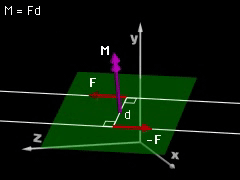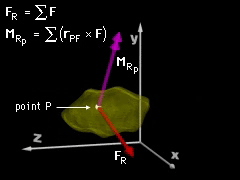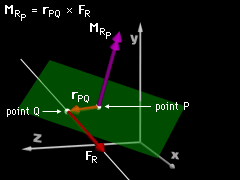| Ch 4. Moments/Equivalent Systems | Multimedia Engineering Statics | ||||||
|
Moment 2-D Scalar |
Moment 3-D Scalar |
Moment 3-D Vector |
Couples and Equiv. System | Distributed Loads, Intro | |||
| Couples and Equivalent Systems | Case Intro | Theory | Case Solution |
| Chapter |
| 1. Basics |
| 2. Vectors |
| 3. Forces |
| 4. Moments |
| 5. Rigid Bodies |
| 6. Structures |
| 7. Centroids/Inertia |
| 8. Internal Loads |
| 9. Friction |
| 10. Work & Energy |
| Appendix |
| Basic Math |
| Units |
| Sections |
| eBooks |
| Dynamics |
| Fluids |
| Math |
| Mechanics |
| Statics |
| Thermodynamics |
| ©Kurt Gramoll |
|
|
||
| Moment of a Couple |
||
 Couple Definition |
A couple is defined as a pair of forces having equal magnitude and opposite direction with different but parallel lines of action. Since the total force in any direction is zero, the net effect of a couple is a pure moment, or torque. The magnitude of this moment is the magnitude of one of the forces times the perpendicular distance between the forces, M = F d The moment vector is perpendicular to the plane containing the lines of action of the two forces. Using a vector approach, the moment of a couple is defined as M = r × F Here r is the position vector from one force to the other, and
F is the force to which r is directed. |
|
| Equivalent Systems |
||
|
Two systems are equivalent if and only if the sum of forces for the two systems is equal and the sum of moments about an arbitrary point in both systems is equal: (ΣF)1 = (ΣF)2 (ΣMp)1
= (ΣMp)2 |
||
| Equivalent Force-Couple System |
||
 Equivalent Force-Couple |
Using the concept of equivalent systems, any system of forces and moments can be replaced by a single force and couple at an arbitrary point P. Applying the conditions for equivalent systems gives FR = ΣF (1) MRP = ΣMP (2) Here each MP is given by the equation MP = rPF × F (3) |
|
| Force Resultant of a System |
||
|
|
If the force and couple of an equivalent force-couple system are perpendicular to one another, we have the equation FR • MRP = 0 The system can be reduced to a single force FR located at a point Q. The moments of the two systems can be equated about the point P giving, MRP = rPQ × FR (4) By substituting Eqs. 1, 2, and 3 into Eq. 4; performing the cross products; and equating the i, j, and k components; the three scalar equation are, Σ(rPFy Fz - rPFz Fy ) = rPQy ΣFz - rPQz ΣFy Σ(rPFz Fx - rPFx Fz ) = rPQz ΣFx - rPQx ΣFz Σ(rPFx Fy - rPFy Fx ) = rPQx ΣFy - rPQy ΣFx Solving this system of three equations for the three unknowns rPQx, rPQy, and rPQz gives the position vector rPQ of the force FR, rPQ = rPQxi + rPQyj + rPQzk FR = ΣF |
|
Practice Homework and Test problems now available in the 'Eng Statics' mobile app
Includes over 500 free problems with complete detailed solutions.
Available at the Google Play Store and Apple App Store.
